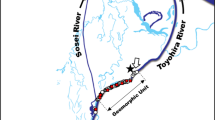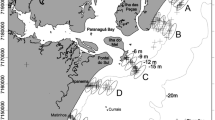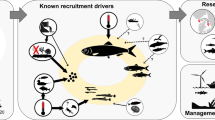Abstract
During their spring migration, Atlantic herring (Clupea harengus) populations in the Baltic Sea rely on shallow transitional waters, such as estuaries, bays, and lagoons for spawning. Such inshore spawning grounds are ecologically important by providing suitable substrates for demersal egg deposition. These habitats are often highly impacted by multiple anthropogenic threats. Decades of eutrophication have caused a decline in depth distribution of submerged aquatic vegetation, the main herring spawning substrate in the Baltic Sea. Nowadays, spawning beds are limited to the shallow littoral zone (≤3 m depth). Accordingly, macrophytes are increasingly exposed to mechanic forcing due to storm-induced wave action. Generally, reproductive success and year class strength of the Western Baltic herring population is strongly determined by the survival of early life stages such as eggs and larvae in local nursery areas. However, explicit mechanisms by which local stressors might affect overall recruitment are currently not well understood. Hypothesizing that aquatic vegetation limited by water depth causes high herring egg mortality due to increased exposure to storm-induced hydrodynamics, we performed a combination of field studies investigating the impact of storm events on herring egg loss. Results of an egg loss experiment revealed a total egg loss of 29% in one single spawning bed during a storm event within the spawning season and the quantification of eggs attached to macrophyte litter on the shoreline emphasize the potential for regional weather extremes such as storm events to act as influential stressors for herring reproduction.




Similar content being viewed by others
References
Alderdice, D.F., and F.P.J. Velsen. 1971. Some effects of salinity and temperature on early development of Pacific herring (Clupea pallasi). Journal Fisheries Research Board of Canada 28: 1545–1562.
Aneer, G. 1987. High natural mortality of Baltic herring (Clupea harengus) eggs caused by algal exudates? Marine Biology 94: 163–169.
Aneer, G. 1989. Herring (Clupea harengus L.) spawning and spawning ground characteristics in the Baltic Sea. Fisheries Research 8: 169–195.
Aneer, G., G. Florell, U. Kautsky, S. Nellbring, and L. Sjöstedt. 1983. In-situ observations of Baltic herring (Clupea harengus membras) spawning behaviour in the Askö-Landsort area, northern Baltic proper. Marine Biology 74: 105–110.
Anwand, K. 1962. Die Fruchtbarkeit der Frühjahrs- und Herbstheringe aus den Gewässern um Rügen. Zeitschrift für Fischerei 11: 463–473 [The fertility of the Rügen spring and autumn spawning herring.]
Balon, E. 1975. Reproductive gulids of fishes: a proposal and definition. Journal Fisheries Research Board of Canada 32: 821–864.
Bishop, M.A., J.T. Watson, K. Kuletz, and T. Morgan. 2015. Pacific herring (Clupea pallasii) consumption by marine birds during winter in Prince William sound, Alaska. Fisheries Oceanography 24 (1): 1–13.
Blaxter, J.H.S. 1956. Herring rearing II. The effect of temperature and other factors on development Marine Research Scotland 5: 1–19.
Blümel, C., A. Domin, C. Krause, M. Schubert, U. Schiewer, and H. Schubert. 2002. Der historische Makrophytenbewuchs der inneren Gewässer der deutschen Ostseeküste. Rostocker Meeresbiologische Beiträge 10: 5–111 [The historical macrophyte coverage of the inner coastal waters of the German Baltic Sea Coast.]
Braum, E. 1973. Einflüsse chronischen exogenen Sauerstoffmangels auf die Embryogenese des Herings (Clupea harengus). Netherlands Journal of Sea Research 7: 363–375 [Impact of chronical exogene oxygen deficiency on the embryogenesis of herring (Clupea harengus).]
Cardinale, M., and F. Arrhenius. 2000. Decreasing weight-at-age of Atlantic herring (Clupea harengus) from the Baltic Sea between 1986 and 1996: a statistical analysis. ICES Journal of Marine Science 57: 882–893.
Casini, M., M. Cardinale, and F. Arrhenius. 2004. Feeding preferences of herring (Clupea harengus) and sprat (Sprattus sprattus) in the southern Baltic Sea. ICES Journal of Marine Science 61: 1267–1277.
Coumou, D., and S. Rahmstorf. 2012. A decade of weather extremes. Nature Climate Change 2: 491–496.
Cruz-Palacios, V., and B.I. van Tussenbroek. 2005. Simulation of hurricane-like disturbances on a Caribbean seagrass bed. Journal of Experimental Marine Biology and Ecology 324: 44–60.
Cushing, D.H. 1975. Marine ecology and fisheries. London: Cambridge University Press 292 pp.
Dennison, W.C. 1987. Effects of light on seagrass photosynthesis, growth and depth distribution. Aquatic Botany 27: 15–26.
Duarte, C.M., and M. Alcaraz. 1989. To produce many small or few large eggs: a size-independent reproductive tactic of fish. Oecologia 80: 401–404.
FAO. 2014. Clupea harengus (Linnaeus, 1758). In: Species Fact Sheets. Ed By FAO.
Foy, R.J., and A.J. Paul. 1999. Winter feeding and changes in somatic energy content of age-0 Pacific herring in Prince William Sound, Alaska. Transactions of the American Fisheries Society 128 (6): 1193–1200.
Geisel, T. 1986. Pflanzensoziologische Untersuchungen am Makrophytobenthos des Greifswalder Boddens. Diploma thesis, University of Rostock, Germany. [Phytosociological investigations of macrophytobenthos in Greifswald Bay.]
Geisel, T., and U. Messner. 1989. Flora und Fauna des Bodens im Greifswalder Bodden. Meer und Museum 5: 44–51 [Flora and fauna of the soil in Greifswald Bay.]
Gröger, J.P., G.H. Kruse, and N. Rohlf. 2010. Salve to the rhythm: how large-scale climate cycles trigger herring (Clupea harengus) regeneration in the North Sea. ICES Journal of Marine Science 67: 454–465.
Haegele, C.W. 1993. Seabird predation of Pacific herring, Clupea pallasi, spawn in British Columbia. Canadian Field-Naturalist 107: 73–82.
Haegele, C.W., and J.F. Schweigert. 1989. Egg loss from Pacific herring spawns in Barkley Sound in 1988. Canadian Manuscript Report of Fisheries and Aquatic Sciences No. 2037:37.
Hart, J.L., and A.L. Tester. 1934. Quantitative studies on herring spawning. Transactions of the American Fisheries Society 64: 307–312.
Hay, D.E., and D.C. Miller. 1982. A quantitative assessent of herring spawn lost by storm action in French Creek, 1980. Canadian Manuscript Report of Fisheries and Aquatic Sciences No. 1636: 1–9.
Hempel, G. 1971. Egg production and egg mortality in herring. Rapports et Proces-verbaux des Réunions. Conseil International pour l’Éxploration de la Mer 160: 8–11.
Hempel, G., and K. Schubert. 1968. Sterblichkeitsbestimmungen an einem Eiklumpen des Nordsee-Herings (Clupea harengus L.). Berichte der deutschen wissenschaftlichen Kommission für Meeresforschung 20: 79–83 [Mortality of North Sea herring egg lump (Clupea harengus).]
Hjort, J. 1914. Fluctuations in the great fisheries of Northern Europe viewed in the light of biological research. Rapports et Proces-verbaux des Réunions. Conseil International pour l’Éxploration de la Mer 237: 20pp.
Houde, E.D. 2008. Emerging from Hjort’s shadow. Journal of Northwest Atlantic Fishery Science 41: 53–70.
Hourston, A., and H. Rosenthal. 1967. Viable hatch from herring eggs torn loose from substrates by storms. Fisheries and Marine Service Research and Development Directorate, Technical Report 653: 5.
ICES (2013) Report of the Herring Assessment Working Group for the Area South of 62N (HAWG). 12–21 March 2013, ICES Headquarters, Copenhagen, Denmark. ICES CM 2013/ACOM:06.
ICES (2014) Report of the Herring Assessment Working Group for the Area South of 62N (HAWG). 11–20 March 2014, ICES Headquarters, Copenhagen, Denmark. ICES CM2014/ACOM:06.1257 pp.
ICES (2015) Report of the Herring Assessment Working Group for the Area South of 62N (HAWG). 10–19 March 2015, ICES Headquarters, Copenhagen, Denmark. ICES CM 2015/ACOM:06.850 pp.
Jones, B.C. 1972. Effect of intertidal exposure on survival and embryonic development of Pacififc herring spawn. Journal Fisheries Research board of Canada 29: 1119–1124.
Kändler, R., and S. Dutt. 1958. Fecundity of Baltic herring. Rapports et Proces-verbaux des Réunions. Conseil International pour l’Éxploration de la Mer 143: 99–108.
Kanstinger, P. 2014. Key environmental factors influencing the early life history of clupeoid fishes, adding nutrients and heat. Ph.D. dissertation, University of Hamburg, Germany.
Kanstinger, P., J. Beher, G. Grenzdörffer, C. Hammer, K.B. Huebert, D. Stepputis, and M.A. Peck. 2016. What is left? Macrophyte meadows and Atlantic herring (Clupea harengus) spawning sites in the Greifswalder Bodden, Baltic Sea. Estuarine, Coastal and Shelf Science: 1–10.
Kell, V. 1989. Das Phytoplankton des Greifswalder Bodden. In Meer und Museum: pp. 25–35. [The phytoplankton of Greifswald Bay.]
Kinne, O., and H. Rosenthal. 1967. Effects of sulfuric water pollutants on fertilization, embryonic development and larvae of the herring, Clupea harengus. Marine Biology 1: 65–83.
Klinkhardt, M. 1984. Zum Einfluß des Salzgehaltes auf die Befruchtungsfähigkeit des Laiches der Rügenschen Frühjahrsheringe. Fischerei-Forschung 22: 73–75 [Impact of salinity on fertilitzation of Rügen spring spawning herring eggs.]
Klinkhardt, M. 1986. Gedanken zur Abhängigkeit der Laichentwicklung Rügenscher Frühjahrsheringe (Clupea harengus L.) von Umweltparametern. Fischerei-Forschung Rostock 24: 22–27 [Thoughts on dependency of Rügen spring herring spawn development on environmental parameters.]
Kotterba, P. 2015. Atlantic herring (Clupea harengus) within the estuarine food web of a southern Baltic Sea lagoon. Ph.D. dissertation, University of Hamburg, Germany.
Kotterba, P., C. Kühn, C. Hammer, and P. Polte. 2014. Predation of threespine stickleback (Gasterosteus aculeatus) on the eggs of Atlantic herring (Clupea harengus) in a Baltic Sea lagoon. Limnology and Oceanography 59: 578–587.
Lambert, T.C. 1990. The effect of population structure on recruitment in herring. ICES Journal of Marine Science 47: 249–255.
Lambert, T.C., and D.M. Ware. 1984. Reproductive strategies of demersal and pelagic spawning fish. Canadian Journal of Fisheries and Aquatic Sciences 41: 1565–1569.
Mataraza, L.K., J.B. Terrell, A.B. Munson, and D.E.J. Canfield. 1999. Changes in submerged Macrophytes in relation to tidal storm surges. Journal of Aquatic Plant Management 37: 3–12.
McGurk, M.D. 1986. Natural mortality of marine pelagic fish eggs and larvae: role of spatial patchiness. Marine Ecology Progress Series 34: 227–242.
Messner, U., and J.A. Von Oertzen. 1990. Recent changes in the Phytal zone of Greifswald Bay. Limnologica 20: 183–186.
Messner, U., and J.A. Von Oertzen. 1991. Long-term changes in the vertical distribution of macrophytobenthic communities in the Greifswalder Bodden. Acta Ichthyologica et Piscatoria 21: 135–143.
Möllmann, C., G. Kornilovs, M. Fetter, and F.W. Köster. 2004. Feeding ecology of central Baltic Sea herring and sprat. Journal of Fish Biology 65: 1563–1581.
Morrison, J.A., J.C. Gamble, and I.R. Napier. 1991. Mass mortality of herring eggs associated with a sedimenting diatom bloom. ICES Journal of Marine Science 48: 237–245.
Munkes, B. 2005a. Eutrophication, phase shift, the delay and the potential return in the Greifswalder Bodden, Baltic Sea. Aquatic Sciences 67: 372–381.
Munkes, B. 2005b. Seagrass Systems-Stability of seagrass systems against anthropogenic impacts. Ph.D. dissertation, University of Kiel, Germany.
Murua, H., and F. Saborido-Rey. 2003. Female reproductive strategies of marine fish species of the North Atlantic. Journal of Northwest Atlantic Fishery Science 33: 23–31.
Nissling, A., A. Müller, and H.-H. Hinrichsen. 2003. Specific gravity and vertical distribution of sprat eggs in the Baltic Sea. Journal of Fish Biology 63: 280–299.
Oeberst, R., M. Dickey-Collas, and R.D.M. Nash. 2009. Mean daily growth of herring larvae in relation to temperature over a range of 5–20°C, based on weekly repeated cruises in the Greifswalder Bodden. ICES Journal of Marine Science 66: 1696–1701.
Ojaveer, E., J. Annist, H. Jankowski, T. Palm, and T. Raid. 1980. On effect of copper, cadmium and zinc on the embryonic development of Baltic spring spawning herring. Finnish Marine Research 247: 135–140.
Ojaveer, E., A. Lumberg, and H. Ojaveer. 1998. Highlights of zooplankton dynamics in Estonian waters (Baltic Sea). ICES Journal of Marine Science 55: 748–755.
Overholtz, W.J., and J.S. Link. 2007. Consumption impacts by marine mammals, fish, and seabirds on the Gulf of Maine - Georges Bank Atlantic herring (Clupea harengus) complex during the years 1977-2002. ICES Journal of Marine Science 64: 83–96.
Peck, M.A., P. Kanstinger, L. Holste, and M. Martin. 2012. Thermal windows supporting survival of the earliest life stages of Baltic herring (Clupea harengus). ICES Journal of Marine Science 69: 529–536.
Petereit, C., H.-H. Hinrichsen, A. Franke, and F.W. Köster. 2014. Floating along buoyancy levels: dispersal and survival of western Baltic fish eggs. Progress in Oceanography 122: 131–152.
Polte, P., P. Kotterba, C. Hammer, and T. Gröhsler. 2014. Survival bottlenecks in the early ontogenesis of Atlantic herring (Clupea harengus, L.) in coastal lagoon spawning areas of the western Baltic Sea. ICES Journal of Marine Science. doi:10.1093/icesjms/fst050.
Rajasilta, M., J. Eklund, J. Kääriä, and K. Ranta-Aho. 1989. The deposition and mortality of the eggs of the Baltic herring Clupea harengus membras L., on different substrates in the south-west archipelago of Finland. Journal of Fish Biology 34: 417–427.
Rajasilta, M., P. Laine, and J. Eklund. 2006. Mortality of herring eggs on different algal substrates (Furcellaria spp. and Cladophora spp.) in the Baltic Sea – An experimental study. Hydrobiologia 554: 127–130.
Richardson, D.E., J.A. Hare, M.J. Fogarty, and J.S. Link. 2011. Role of egg predation by haddock in the decline of an Atlantic herring population. Proceedings of the National Academy of Sciences 108: 13606–13611.
Rooper, C.N. 1996. Physical and Biological Factors affecting Pacific Herring Egg Loss in Prince William Sound, Alaska. M.Sc. thesis, University of Alaska Fairbanks, Juneau, USA.
Rooper, C.N., L.J. Haldorson, and T.J. Quinn. 1999. Habitat factors controlling Pacific herring (Clupea pallasi) egg loss in Prince William sound, Alaska. Canadian Journal of Fisheries and Aquatic Sciences 56: 1133–1142.
Rosenthal, H., and K.-R. Sperling. 1974. Effects of cadmium on Development and Survival of Herring Eggs. In The Early Life History of Fish: The Proceedings of an International Symposium Held at the Dunstaffnage Marine Research Laboratory of the Scottish Marine Biological Association at Oban, Scotland, from May 17–23, 1973, ed. J.H.S. Blaxter, 383–396. Berlin, Heidelberg: Springer Berlin Heidelberg.
Sætre, R., R. Toresen, and T. Anker-Nilssen. 2002. Factors affecting the recruitment variability of the Norwegian spring-spawning herring (Clupea harengus L.). ICES Journal of Marine Science 59: 725–736.
Scabell, J. 1988. Der Rügensche Frügjahrshering - das Laichgeschehen. Ph.D. dissertation, University of Rostock, Germany. [Rügen spring herring – the spawning event.]
Schiewer, U. 2001. Salzhaff, Greifswalder Bodden, Darß-Zingster Boddenkette: Gewässereutrophierung und Pufferkapazität - ein Vergleich. Rostocker Meeresbiologische Beiträge 9: 5–19 [Salzhaff, Greifswald Bay and Darß-Zingster Boddenkette: Eutrophication and buffering capacity.]
Schiewer, U. 2008. Chapter 4. Greifswalder Bodden, Wismar-Bucht and Salzhaff. In Ecology of Baltic coastal waters, 87–111. Verlag: Springer.
Schnese, W. 1973. Untersuchungen zur Produktionsbiologie des Greifswalder Boddens (südliche Ostsee) I. die Hydrographie: Salzgehalt, Sauerstoffgehalt, Temperatur und Sestongehalt. Wissenschaftliche Zeitschrift der Universität Rostock 22: 629–639 [Investigations on production biology of Greifswald Bay (southern Baltic Sea) I. Hydrography: Salinity, Oxygen content, Temperature and seston content.]
Schoknecht, G. 1973. Einige Untersuchungsergebnisse über die Wasserbeschaffenheit des Greifswalder Boddens. Acta Hydrochimica et Hydrobiologica 1: 387–395 [Some results on water quality of Greifswald Bay.]
Stigge, H.-J. 1989. Der Wasserkörper Bodden und seine Hydrodynamik. Meer und Museum 5: 10–14 [The water body and the hydrodynamics of Greifswald Bay.]
Sundby, S. 1991. Factors affecting the vertical distribution of eggs. ICES Marine Science Symposia 192: 33–38.
Taylor, F.H.C. 1964. Life history and present status of British Columbia herring stocks. Bulletin of the Fisheries Research Board of Canada 143 81 pp.
Tester, A.L., and J.C. Stevenson. 1948. Results of the west coast of Vancouver Island herring investigation, 1947-48. Report of British Columbia Fisheries Department 1946: 42–71.
Urho, L. 1999. Relationship between dispersal of larvae and nursery areas in the Baltic Sea. ICES Journal of Marine Science 56: 114–121.
Von Westernhagen, H., V. Dethlefsen, and H. Rosenthal. 1979. Combined effects of cadmium, copper and lead on developing herring eggs and larvae. Helgoländer Wissenschaftliche Meeresuntersuchungen 32: 257–278.
Wootton, R.J. 1990. Ecology of teleost fishes. London: Chapman and Hall.
Woth, K., R. Weisse, and H. Von Storch. 2006. Climate change and North Sea storm surge extremes: an ensemble study of storm surge extremes expected in a changed climate projected different regional climate models. Ocean Dynamics 56: 3–15.
Acknowledgements
We would like to thank the many student helpers and our colleagues from the Thünen Institute of Baltic Sea Fisheries who contributed to this study, especially Rainer Oeberst and Dr. Marta Moyano from the University of Hamburg who provided constructive comments and suggestions on the Figures. We would like to thank the editors and three anonymous reviewers for their helpful comments. Thanks are extended to the German National Meteorological Service (DWD) for providing the wind data. The research leading to these results received funding from BONUS INSPIRE (D.M.) and BONUS BIO-C3 (P.K.), the joint Baltic Sea research and development program (Art 185), funded jointly by the European Union and the Federal Ministry of Education and Research of Germany (BMBF 03F0681; 03F0682). L.v.N. received funds from the German Federal Environmental Foundation (DBU), and P.P. was funded by the EU Data Collection Framework (DCF).
Author information
Authors and Affiliations
Corresponding author
Additional information
Communicated by Josianne G. Støttrup
Electronic Supplementary Material
ESM 1
(PDF 675 kb)
Rights and permissions
About this article
Cite this article
Moll, D., Kotterba, P., von Nordheim, L. et al. Storm-Induced Atlantic Herring (Clupea harengus) Egg Mortality in Baltic Sea Inshore Spawning Areas. Estuaries and Coasts 41, 1–12 (2018). https://doi.org/10.1007/s12237-017-0259-5
Received:
Revised:
Accepted:
Published:
Issue Date:
DOI: https://doi.org/10.1007/s12237-017-0259-5




